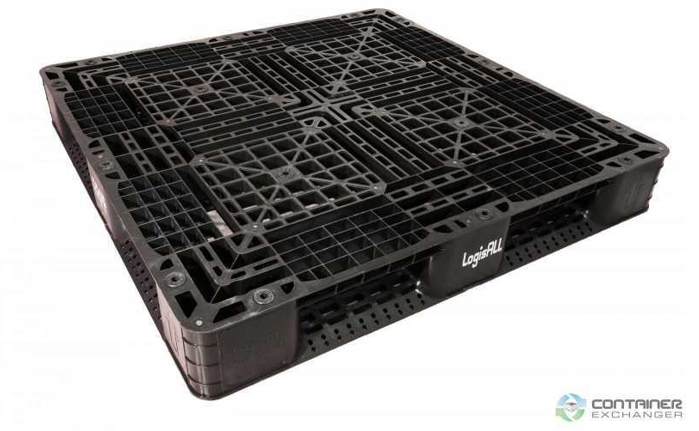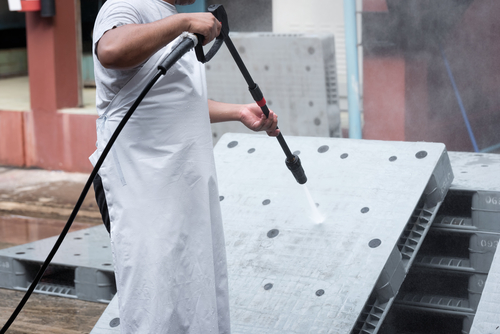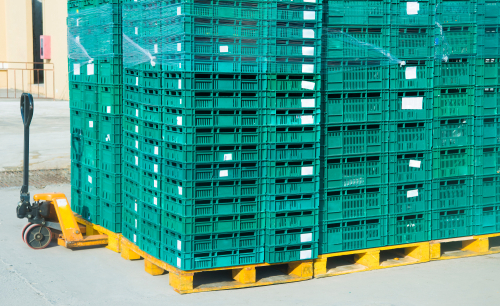Almost every storage and warehouse facility use pallets, whether they are plastic or metal. These handy items make it easy to move heavy items with a forklift but working with pallets can also lead to injury if you or your team isn’t taking proper precautions. While pallets may seem harmless, they can be more dangerous than you might expect when used improperly. OSHA lays out clear guidelines for lifting weighted pallets, but empty pallets can be a hazard as well. Use these safety tips to make sure your employees handle all your pallets with care.
1. Never Stand on the Pallet
Pallets should be used for lifting and moving cargo, not for giving a boost to your employees. While pallets are designed to hold large amounts of weight, they may only work if the weight is distributed evenly. When your employees stand on the pallet, all the weight is limited to where their feet touch the pallet. Their feet could easily break through the pallet, causing injury. Plastic and metal pallets can also easily slide around on the floor, so refrain from standing on them or using them to reach high places.
2. Never Stack Pallets on Their Side
Pallets aren’t meant to be stacked on their side. Leaning your pallets against the wall or another surface can put your employees at risk. Your pallets may not be stable, so there’s a chance they could fall or tip over, crushing one of your employees if they happen to be nearby.
3. Wear Protective Clothing
Make sure you and your team wear protective clothing when handling pallets. It’s best to wear gloves when handling pallets so your fingers don’t accidentally get crushed between two pallets, your cargo and the pallet or the pallet and the floor. The same goes for your toes, so make sure to wear protective footwear. Metal pallets can also create loud noises when they land on the floor, especially if they fall, drop suddenly or from high places. You may want to wear earplugs so you don’t damage your ears when using metal pallets. You should also get in the habit of handling your pallets with care so they’re less likely to fall or smack against the floor.
4. Thoroughly Inspect Pallets Before Using Them
You should never use damaged or broken pallets in your storage or warehouse facility. One of your employees or your cargo could easily fall through the pallet if it’s damaged in any way. Your cargo could also tip or fall over, crushing an employee. Spend some time inspecting your pallets before you put them back in the supply chain.
If you buy used pallets, clean them and inspect them before putting them to work. Work with reliable, quality pallet resellers like Container Exchanger to make sure you always find quality used pallets.
5. Clean Up After Your Pallets
Wooden pallets can easily spread debris like wood chips and shavings, but the same goes for your plastic and metal pallets as well. Metal and plastic shavings can collect on the floor when you and your team are using your pallets on a regular basis. Remember to regularly sweep the floor of your facility and be on the lookout for debris that could cause one of your employees to slip and fall. Again, handle your pallets with care to prevent damage and the spread of debris.
6. Use Caution When Lifting or Moving Pallets
You should always use a forklift when lifting or moving your weighted pallets, but what about empty pallets? Some pallets can weigh anywhere between 20 and 70 pounds. If you and your employees are used to lifting pallets by hand, use lightweight pallets to avoid injury. Use caution when lifting heavier pallets by hand. It’s best to have two people lift the pallet with one person on each side. Lift with your knees and keep the pallet close to your abdomen or chest.
7. Never Over-Stack Your Pallets
It’s best to stack pallets horizontally so they don’t fall or tip over, but stacking your pallets too high can also be a hazard. Avoid stacking your pallets more than four feet into the air so they don’t fall on top of your employees.
Final Thoughts
Keep these tips in mind when working with metal and plastic pallets. Train all new and existing employees on how to properly handle and move pallets. Post these safety rules and regulations throughout your facility so your employees stay safe while they’re on the job.


